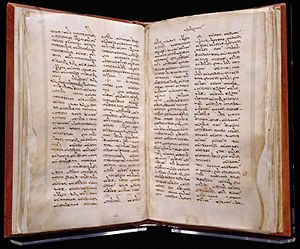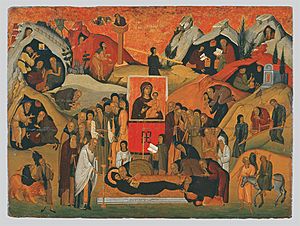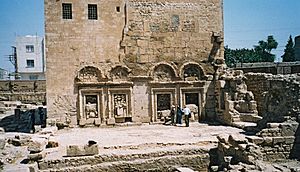Ephrem the Syrian facts for kids
Quick facts for kids SaintEphrem the Syrian |
|
|---|---|

Mosaic in Nea Moni of Chios (11th century)
|
|
|
|
| Born | c. 306 Nisibis (modern-day Nusaybin, Turkey) |
| Died | 9 June 373 Edessa (modern-day Şanlıurfa, Turkey) |
| Venerated in | |
| Feast |
|
| Attributes | Vine and scroll, deacon's vestments and thurible; with Saint Basil the Great; composing hymns with a lyre |
| Patronage | Spiritual directors and spiritual leaders Syriacs/Arameans |
Ephrem the Syrian (born around 306, died 373) was a very important Christian writer and thinker. He is also known as Saint Ephrem or Ephrem of Edessa. He is famous for writing many Christian songs and poems called hymns. People in Eastern Christian churches especially remember him for his beautiful hymns.
Ephrem was born in a city called Nisibis, which is now in Turkey. He served as a deacon, which is a church leader. Later, he lived in Edessa, another city in modern-day Turkey. All traditional Christian churches honor him as a saint. In 1920, the Roman Catholic Church declared him a "Doctor of the Church." This means he was a great teacher of Christian faith. Ephrem is also believed to have started the School of Nisibis, a famous learning center.
Ephrem wrote many hymns, poems, and sermons. These writings helped Christians understand their faith during difficult times. His works were so popular that many writers copied his style for centuries after he died. He is considered the most important writer in the Syriac-speaking Christian tradition. Many Syriac Christians see him as their special protector.
Contents
Ephrem's Life Story
Ephrem was born around 306 AD in Nisibis. This city was part of the Roman Empire at the time. His parents were likely Christians, even though some stories later said his father was a pagan priest. In those days, people in Nisibis followed different religions, including local beliefs, Judaism, and various Christian groups. Most people spoke Aramaic, a language similar to Syriac.
Early Years and Education
Jacob, the bishop of Nisibis, became a leader in 308 AD. Ephrem grew up under his guidance. Ephrem was baptized when he was young. He probably joined a group called "sons of the covenant," which was an early form of monastic life. Bishop Jacob made Ephrem a teacher, a role that was highly respected. He also became a deacon in the church.
As a teacher, Ephrem began writing hymns and explaining parts of the Bible. He sometimes called himself a "herdsman" and his bishop a "shepherd," comparing his community to a "fold." People believe Ephrem founded the School of Nisibis. This school became a very important place for learning in the Church of the East.
Life During War
In 337 AD, Emperor Constantine I died. He was the emperor who made Christianity legal in the Roman Empire. After his death, Shapur II, the Persian king, started attacking Roman lands in Mesopotamia. Nisibis was attacked three times: in 338, 346, and 350. During the first attack, Ephrem believed Bishop Jacob's prayers saved the city.
In the third attack in 350, Shapur tried to flood the city by changing the course of the Mygdonius River. But the people of Nisibis quickly fixed their walls. The Persian elephant cavalry got stuck in the mud. Ephrem wrote a hymn celebrating this event. He compared Nisibis to Noah's Ark, floating safely on the flood.
A special building from Ephrem's time is the baptistery of Nisibis. A carving there shows it was built in 359 AD. In that same year, Shapur attacked again. Many cities around Nisibis were destroyed. In 363 AD, the Roman emperor Jovian had to give Nisibis to Persia to save his army. All Christians, including Ephrem, had to leave the city.
Moving to Edessa
Ephrem and other Christians first went to Amida, then settled in Edessa in 363 AD. Ephrem was in his late fifties. He continued his church work and teaching, possibly at the School of Edessa. Edessa was a big center for Aramaic-speaking people. It was also a place with many different philosophies and religions.
Ephrem noticed that many groups in Edessa claimed to be the true church. To help his community, he wrote many hymns defending the main Christian beliefs. A later writer said that Ephrem even trained all-female choirs to sing his hymns in the city square. After living in Edessa for ten years, Ephrem died from a plague in 373 AD. He was in his sixties and had been helping those who were sick.
Ephrem's Writings
Ephrem wrote all his works in his native Aramaic language, specifically the dialect spoken in Edessa, which later became known as Classical Syriac. He often referred to his language as "Aramaic" and his people as "Arameans." He is known as the "true voice of Aramaic Christianity."
Hymns and Poems
More than 400 hymns written by Ephrem still exist today. He was a very productive writer. His most important works are his teaching hymns, called madrāšê. These hymns are full of rich, poetic images from the Bible and local traditions. They were written in stanzas with different rhythms. Each hymn had a special tune, but these tunes are now lost.
Ephrem used hymns to teach people and to argue against false teachings. He wanted to protect Christians from ideas that could divide the early church. He wrote hymns that explained Christian beliefs in detail. For example, his Hymns Against Heresies used colorful comparisons to describe Jesus Christ as both fully human and fully divine.
Ephrem also wrote verse homilies, which were like sermons in poetry. These were fewer in number than his hymns. They were written in pairs of lines, each with seven syllables.
Prose Works
Ephrem also wrote prose works. He wrote a commentary on the Diatessaron, which was a single book combining all four gospels used in the early Syriac church. The original Syriac version of this commentary was found in 1957. He also wrote a commentary on the books of Genesis and Exodus from the Bible.
Many of Ephrem's hymns are still used in Syriac churches today during their worship services. However, most of these hymns have been changed or combined over time.

Greek Ephrem
Ephrem's ideas and his fight against false teachings made him very popular. Because of this, many works were written in his name, even if he didn't actually write them. These are called "pseudepigrapha." A large number of these works exist in Greek and are often called "Greek Ephrem."
One of the most famous of these writings is the Prayer of Saint Ephrem. This prayer is said during every church service in Eastern Christianity during the fasting period of Great Lent. There are also works attributed to "Ephrem" in Latin, Slavonic, and Arabic.
Honored as a Saint
Soon after Ephrem died, stories about his life began to spread. Some of these stories changed over time. For example, one story said his father was a pagan priest, but Ephrem's own writings suggest he was raised by Christian parents.
Ephrem is seen as a great example of monastic life in Eastern Christianity. In the Eastern Orthodox tradition, he is called a Venerable Father, meaning a sainted monk. His feast day is celebrated on January 28th.
On October 5, 1920, Pope Benedict XV declared Ephrem a Doctor of the Church. This is a special title given to saints who have made important contributions to Christian teaching.
Ephrem's most popular nickname is Harp of the Spirit. He is also called the Deacon of Edessa, the Sun of the Syrians, and a Pillar of the Church.
His feast day in the Roman Catholic Church is June 9th, which is the date of his death.
Ephrem is also honored with a feast day on the liturgical calendar of the Episcopal Church (USA) on June 10th. The Church of England remembers him on June 9th.
Translations
- San Efrén de Nísibis Himnos de Navidad y Epifanía, by Efrem Yildiz Sadak Madrid, 2016 (in Spanish). ISBN: 978-84-285-5235-6
- Sancti Patris Nostri Ephraem Syri opera omnia quae exstant (3 vol), by Peter Ambarach Roma, 1737–1743.
- St. Ephrem Hymns on Paradise, translated by Sebastian Brock (Crestwood, NY: St. Vladimir's Seminary Press, 1990). ISBN: 0-88141-076-4
- St. Ephrem the Syrian Commentary on Genesis, Commentary on Exodus, Homily on our Lord, Letter to Publius, translated by Edward G. Mathews Jr., and Joseph P. Amar. Ed. by Kathleen McVey. (Washington, DC: Catholic University of America Press, 1994). ISBN: 978-0-8132-1421-4
- St. Ephrem the Syrian The Hymns on Faith, translated by Jeffrey Wickes. (Washington, DC: Catholic University of America Press, 2015). ISBN: 978-0-8132-2735-1
- Ephrem the Syrian Hymns, introduced by John Meyendorff, translated by Kathleen E. McVey. (New York: Paulist Press, 1989) ISBN: 0-8091-3093-9
- Saint Ephrem's Commentary on Tatian's Diatessaron: An English Translation of Chester Beatty Syriac MS 709 with Introduction and Notes, translated by Carmel McCarthy (Oxford: Oxford University Press, 1993).
- Saint Ephraim the Syrian Eschatological Hymns and Homilies, translated by M.F. Toal and Henry Burgess, amended. (Florence, AZ: SAGOM Press, 2019). ISBN: 978-1-9456-9907-8
See also
- Syriac language
- Syria (region)
- Efrén de Siria para niños (in Spanish)







